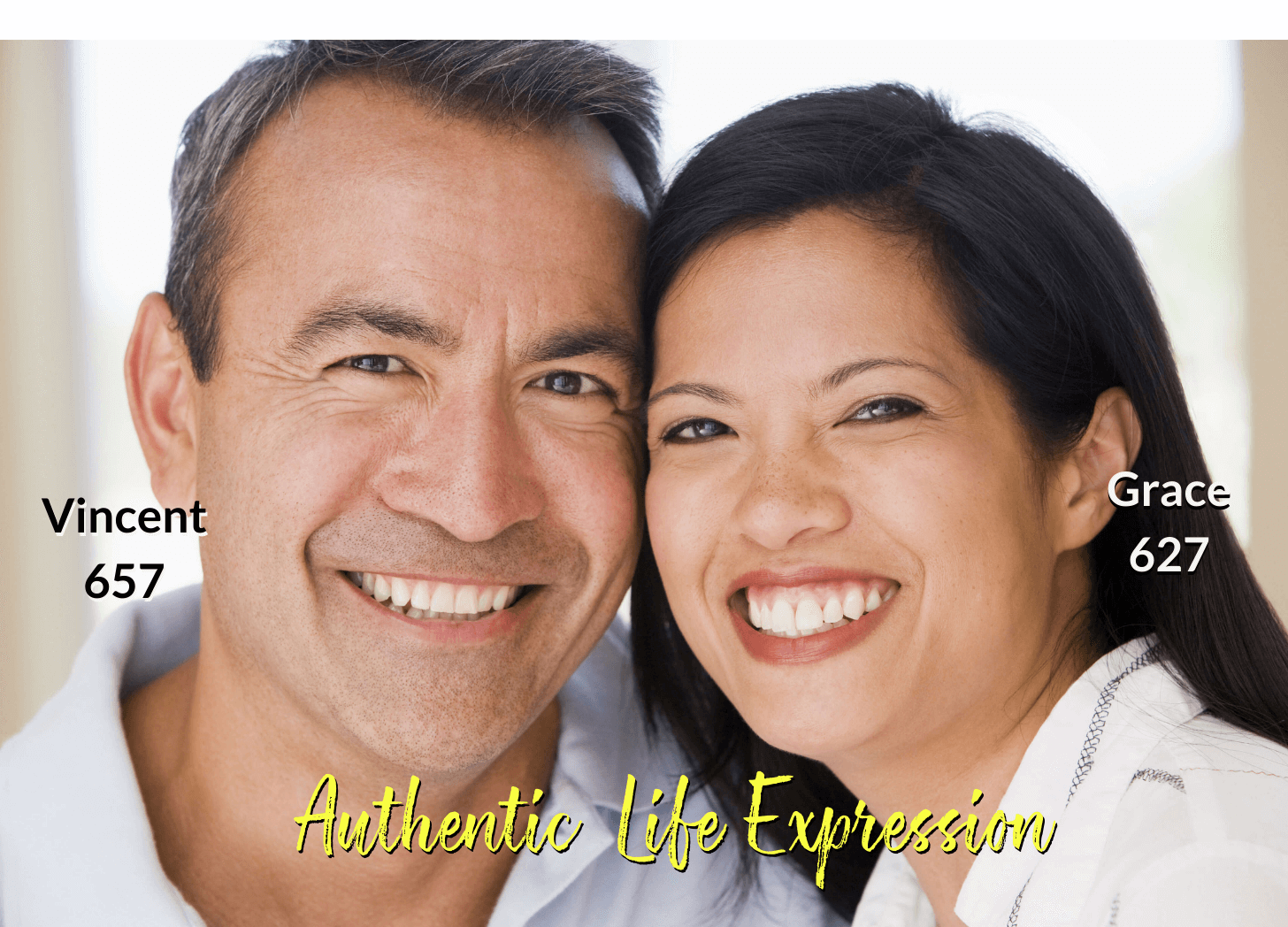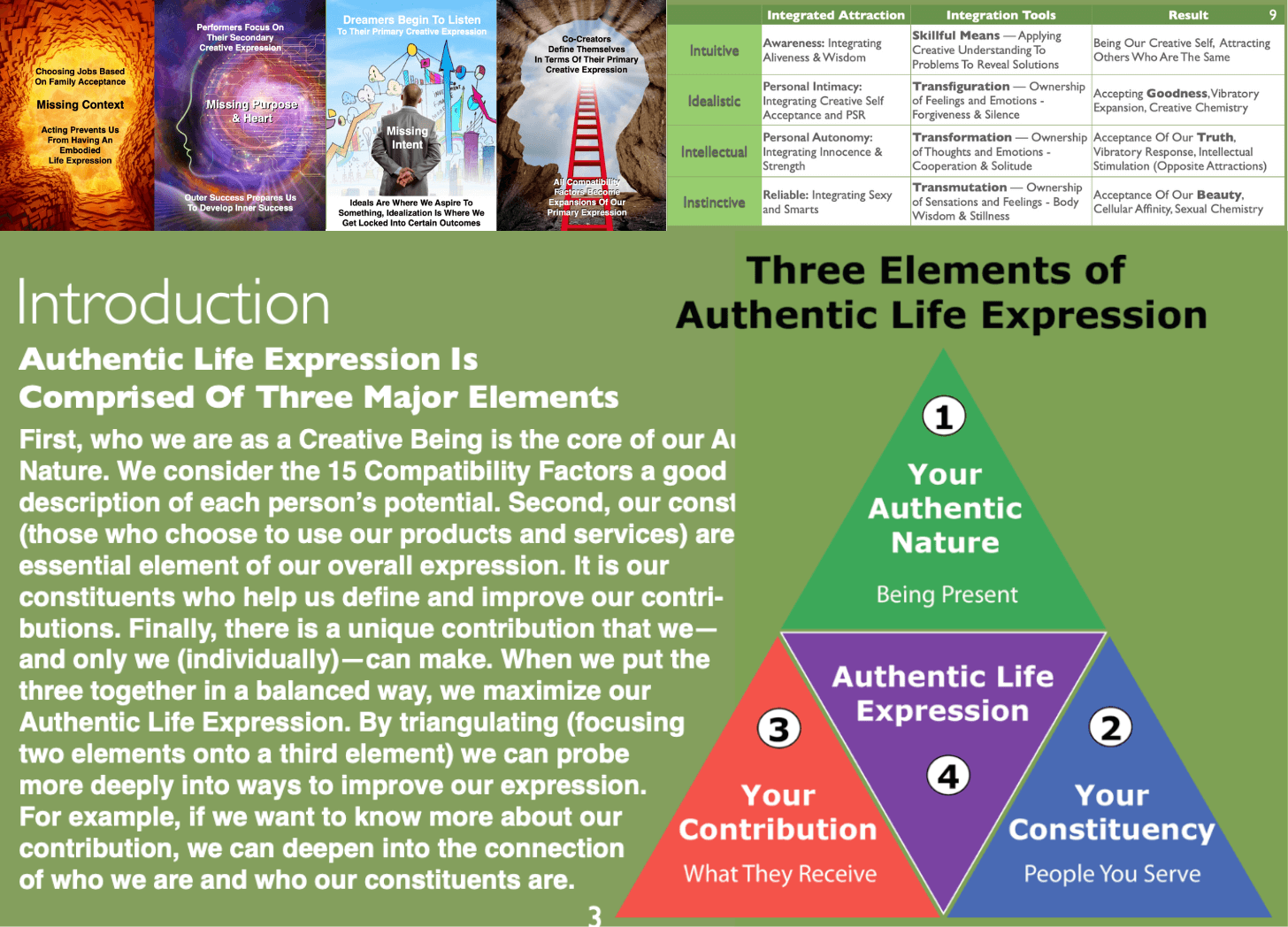Why Pretending is Exhausting, Performing is a Trap, Dreaming is Lonely — and Living Your Creative Design is the Only Game Worth Playing
Most of us spend our lives as understudies in someone else’s drama. We act, perform, or dream — but rarely express. Authentic Life Expression (ALE) is about ending the audition and stepping onto the stage of our own life. It’s not about being impressive, secure, or even “special.” It’s about embodying our Creative Design, the inner architecture of who we are, and offering it as a gift to the greater good.
Now, before you roll your eyes — no, this isn’t another “just follow your passion” pep talk. Authentic Life Expression is both more demanding and more fulfilling. It calls us to transmute our inherited beliefs, transform our tired thought patterns, and transfigure our shallow means of fulfillment. It calls us to put ourselves in the right place, at the right time, with the right contribution — consistently. That’s a tall order. But here’s the good news: when we do, we discover the joy of Co-Creation. Instead of life being a job interview for validation, it becomes a dance of change, growth, and striving that makes us radiantly alive.
Unfortunately, most of us don’t start there. We start by faking it…
The Three Big Obstacles: Actors, Performers, Dreamers
Actors: The Safety-Driven Pretenders
Actors are the people who learn early that if they act in pre-set ways, they’ll gain attention. They use sensations and feelings as their props, shaping how the world sees them. Safety is their north star: don’t stand out too much, but also are slightly ignored. As pretenders, we seek to live up to Expectations. Acting is shallow because it isn’t about creating; it’s about fitting in so we will not be punished. The life lesson of the Actor is simple but brutal: The consequences of staying in the shadows are regret, pain, and never being fulfilled.
Performers: The Security-Driven Opportunists
Performers are more sophisticated. They’ve upgraded from acting to playing positional chess. They use emotions and thoughts to strategize, seeking security through success. As Performers, they seek to live up to others' demands so that they can make their own. They study leadership hacks, leverage their situations, and chase promotions. They’re not interested in contribution — they’re interested in winning. They think money equals meaning. Performers are opportunists and controllers, trying to divert our attention by wearing Armani suits. The life lesson of the Performer: success without contribution feels like eating cardboard.
Dreamers: The Significance-Driven Stuck Ones
Dreamers are intoxicated by ideals. They anchor themselves in feelings and emotions, fantasizing about possibilities they can’t yet manifest. They want to make a difference, but their execution is all thumbs. They recycle old plans, float on lofty ideas, and wait for the world to notice their brilliance. They can be romantics and divert attention away from reality. They often lack preparation, planning, and sometimes the courage to act. The life lesson of the Dreamer: without embodiment, dreams are time-wasting mirages.
The sad truth? Most people get stuck in one or more of these roles. That’s why research shows only 16–19% of people consistently make authentic contributions. Everyone else is trapped in Pretenses, Defenses, Distortions, or Parental Imprints.
The False Frames that Block Us
Pretenses → How we want to be seen (expectations, control, romantic myths).
Defenses → How we allow ourselves to be seen (Distant, Dynamic, Disarming, etc.).
Distortions → False beliefs about what motivates us (e.g., “Money is the goal”).
Parental Imprints → Patterns we learned to make others happy at our expense.
Together, these frames distort our Creative Nature. They trick us into seeking validation instead of contribution. They turn life into an exhausting masquerade ball.
The Authentic Life Expression (ALE) Model
To cut through the noise, Higher Alignment developed a new model for Authentic Life Expression (ALE). Historically, we haven’t had a way of understanding and choosing partners based on having common activities and life purpose. This framework provides 15 key qualities that define ALE: 3 Virtues, 3 Inner Values, 3 Outer Values, 3 Mental Body Expectations, and 3 Creative Impulses. Together, they describe not only who we are but also how we contribute at the deepest level.
Masculine approaches force you to confront how others define you rather than internally defining what resonates with you. This is why we say the feminine approach is gentler and easier to explore on its own terms. It first uses connected breath and direct perception to discover the three levels of our Primary Creative Expression:
Virtues → transpersonal motivations that connect us to contribution.
Values → guiding principles that shape our standards.
Creative Impulses → spontaneous actions that create the right opportunities.
Then it shows how these reconcile with:
Secondary Creative Expression → three outer Values to balance with Primary’s inner Values.
Mental Body Creative Expression → three Expectations to reconcile with Primary’s Creative Impulses.
Finally, the deepest reconciliation: Embodying our Virtues independent of anyone else. This is when we stop hustling for permission and start radiating our design.
Vincent & Grace: A Case Study in Becoming A Contributor
Let’s meet Vincent (657) and Grace (627). They are both Visionaries at the Primary Creative level. High similarities create confrontations with upper boundary limits that need to be grounded before we see the benefit of their commonalities. With their commonalities, they are confronted with every place that they are denying themselves love, which is being mirrored in their partner. Their story is a living example of how Authentic Life Expression isn’t smooth, but it is sustaining.
Vincent’s Journey
Vincent spent his twenties being cautious. He took jobs his family approved of — administrative, low-risk, predictable. But by 28, he cracked. In rebellion, he took a sales job. Sixty percent of his pay depended on commissions. He went all in as a performer — money, competition, hustle. Within eight years, he was earning over $ 300,000. From the outside, he looked successful. Inside, he was cooked. By 36, he was burned out, disgusted with his own opportunism. He switched to a non-profit, hoping “meaning” would fix the void. But idealism without grounding left him frustrated. He saw the suffering abroad, and realized care wasn’t about money — it was about access. His Dreamer phase was no better than his Performer phase. Only then did he start his Higher Alignment Creative Assessment and begin exploring his Virtues, Values, and Impulses. Here are the Visionary Virtues, Values, and Creative Impulses.
Visionary Virtues:
- Heart-Based Direct Knowing
Ability to intuitively sense universal truths through emotional clarity.
- Inspirational Unity & Trust
The capacity to bring people together around shared ideals and purpose.
- Purity & Strength of Purpose
Focus and dedication to a transpersonal mission or vision.
Visionary Values:
- Faith & Sincerity
Belief in the goodness of people and causes, coupled with honest commitment.
- Earnest Humility
Selflessness and openness to divine or collective guidance.
- Empathic Communion
A deep sense of shared experience and sacred connection to others.
Visionary Creative Impulses:
- Aspiration & Belief
Idealistic yearning to uplift others and realize dreams.
- Devotion & Ardor
Passionate pursuit of personal, transpersonal, or spiritual calling.
- Spiritual Idealism
Desire to manifest inner truth through outer service and compassion.
Grace’s Journey
Grace’s path looked different but rhymed. It rhymed because it was a mirror image of her motivations, which, like Vincent’s, were driven by her Primary Visionary Creative Expression. She followed her aunt into nursing — safe, respected, useful. She specialized as a surgical nurse — pure Performer, chasing security. Then she switched to hospice — Dreamer territory, longing for significance. But she got stuck in the emotional intensity of death. Finally, she pivoted into health policy, wanting to effect systemic change, not just personal impact. But this required persuasion, leadership, and the courage to face political pushback. She realized her authentic gift wasn’t in doing tasks but in advocating at scale.
When Vincent Met Grace
When they met, sparks flew — but not just romantically. They discovered a shared hunger for authentic contribution. Grace’s stories of creative possibilities jolted Vincent. He got his Creative Assessment and suddenly had words for the longing he’d carried. Together, they started mapping their Virtues, Values, and Impulses.
For Vincent, it was about shifting from “outer success” to “service.” For Grace, it was about moving from “dreaming of contribution” to “creative advocacy.” Their conversations became a laboratory of Mutual Learning. They challenged each other’s Pretenses. They mirrored each other’s distortions and found it uncomfortable and revealing. They poked fun at their Actor, Performer, and Dreamer tendencies.
Instead of breaking them, these tensions made them stronger. They began Co-Creative projects, including a healthcare equity initiative, a storytelling podcast that highlights frontline caregivers, and a mentoring circle for younger professionals who are stuck in Performer-mode.
Virtues, Values, Expectations, Creative Impulses
Vincent’s center of gravity is his Visionary Primary, where Intuition and Inspiration fuel his sense of purpose. His Inner Values of Faith, Sincerity, and Humility drive him to test whether ideas resonate deeply with who he is. His impulses drive him to envision future possibilities and inspire others with them. The Investigator Outer Values of Linear Lucidity, Technical Precision, and Thought Form Definition temper his Visionary openness with rigor, demanding clarity and evidence before commitment. Finally, his Storyteller Mental Body aligns him with Grace in that they both operate based on expectation, utilizing Captivation and Integration, Pattern Building Organization, and Symbolic Living Revelation.
Grace shares Vincent’s Visionary foundation: Like Vincent, she is guided by Authenticity and a quest for Alignment. Her impulses lean toward visioning and inspiring others. The Compassionate Outer Values, however, guide her visioning with Sharing Gracefully, Serenity, Patience, and Understanding Love in her relationships — she emphasizes empathy, human connection, and inclusivity as her standards. Her Storyteller Mental Body aligns her with Vincent’s, as both expect experiences to weave into a meaningful, creative story.
The key takeaway is that each had to reconcile their Secondary and Mental Body Creative Expressions before they could relax into their Primary. For Vincent, this meant dropping Performer ambition (outer Value of “winning”) to embrace his Primary Value of “service.” For Grace, it meant reconciling her Mental Body Expectation of “using humor to skate” with her Impulse toward “advocacy.”
Why They Work
Most couples are torn apart by differences in Creative Expressions. However, Vincent is 657, and Grace is 627. They have minimal differences; the main one is his Secondary Investigator versus her Secondary, Compassionate. This does not mean that all their factors are similar, as several of their main compatibilities differ. But because they both committed to finding their Authentic Life Expression, they turned those differences into resonance.
Mutual Learning cemented their bond.
Autonomy gave them room to grow.
Co-Creative projects gave them a shared purpose.
Instead of getting stuck in Actor/Performer/Dreamer traps, they pushed each other to embody their Virtues and Impulses. Their relationship became not a distraction but a vehicle for contribution.
The Answer
Authentic Life Expression isn’t about fixing the world with grand gestures. It’s about becoming a better version of yourself in the world— and sharing that version. Vincent and Grace prove that even when the journey is messy, it can deepen love. What could have broken them made them Radiant.
So, stop acting. Stop performing. Stop dreaming. Start expressing! Because your gift isn’t in being safe, secure, or significant. Your gift is in being Authentically You — radiantly, creatively, unapologetically. And when you do, you don’t just live. You contribute.
Wishing you a deep commitment to your contribution, so your inner meaning transfigures you.
Larry
Founder, Higher Alignment


